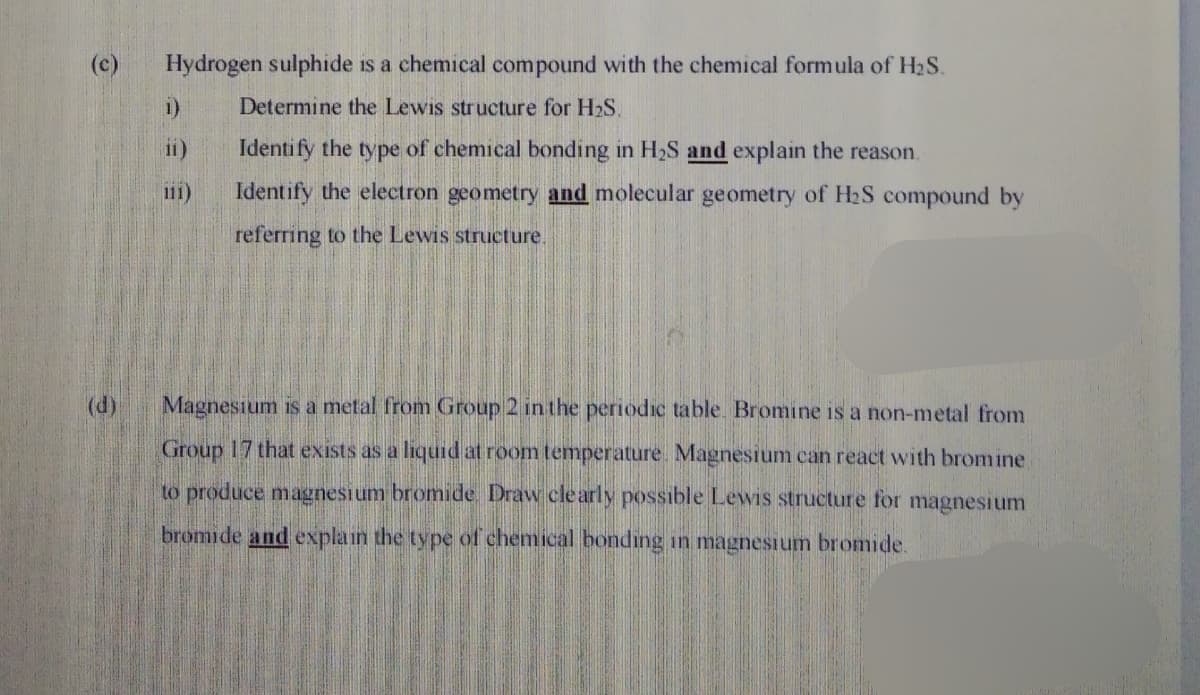(c) Hydrogen sulphide is a chemical compound with the chemical formula of H2S. i) Determine the Lewis structure for H2S. 11) Identify the type of chemical bonding in H2S and explain the reason. 111) Identify the electron geometry and molecular geometry of H2S compound by referring to the Lewis structure.
(c) Hydrogen sulphide is a chemical compound with the chemical formula of H2S. i) Determine the Lewis structure for H2S. 11) Identify the type of chemical bonding in H2S and explain the reason. 111) Identify the electron geometry and molecular geometry of H2S compound by referring to the Lewis structure.
Principles of Modern Chemistry
8th Edition
ISBN:9781305079113
Author:David W. Oxtoby, H. Pat Gillis, Laurie J. Butler
Publisher:David W. Oxtoby, H. Pat Gillis, Laurie J. Butler
Chapter3: Atomic Shells And Classical Models Of Chemical Bonding
Section: Chapter Questions
Problem 101AP: (a) Predict the geometry of the SbCl52 ion, using the VSEPR method. (b) The ion SbCl63 is prepared...
Related questions
Question
100%

Transcribed Image Text:(c)
Hydrogen sulphide is a chemical compound with the chemical formula of H2S.
1)
Determine the Lewis structure for H2S.
ii)
Identify the type of chemical bonding in H2S and explain the reason.
111)
Identify the electron geometry and molecular geometry of H2S compound by
referring to the Lewis structure.
(d)
Magnesium is a metal from Group 2 in the periodic table. Bromine is a non-metal from
Group 17 that exists as a liquid at room temperature. Magnesium can react with bromine
to produce magnesium bromide. Draw cle arly possible Lewis structure for magnesium
bromide and explain the type of chemical bonding in magnesium bromide.
Expert Solution
This question has been solved!
Explore an expertly crafted, step-by-step solution for a thorough understanding of key concepts.
This is a popular solution!
Trending now
This is a popular solution!
Step by step
Solved in 5 steps with 1 images

Knowledge Booster
Learn more about
Need a deep-dive on the concept behind this application? Look no further. Learn more about this topic, chemistry and related others by exploring similar questions and additional content below.Recommended textbooks for you

Principles of Modern Chemistry
Chemistry
ISBN:
9781305079113
Author:
David W. Oxtoby, H. Pat Gillis, Laurie J. Butler
Publisher:
Cengage Learning

World of Chemistry, 3rd edition
Chemistry
ISBN:
9781133109655
Author:
Steven S. Zumdahl, Susan L. Zumdahl, Donald J. DeCoste
Publisher:
Brooks / Cole / Cengage Learning

Chemistry
Chemistry
ISBN:
9781305957404
Author:
Steven S. Zumdahl, Susan A. Zumdahl, Donald J. DeCoste
Publisher:
Cengage Learning

Principles of Modern Chemistry
Chemistry
ISBN:
9781305079113
Author:
David W. Oxtoby, H. Pat Gillis, Laurie J. Butler
Publisher:
Cengage Learning

World of Chemistry, 3rd edition
Chemistry
ISBN:
9781133109655
Author:
Steven S. Zumdahl, Susan L. Zumdahl, Donald J. DeCoste
Publisher:
Brooks / Cole / Cengage Learning

Chemistry
Chemistry
ISBN:
9781305957404
Author:
Steven S. Zumdahl, Susan A. Zumdahl, Donald J. DeCoste
Publisher:
Cengage Learning


Chemistry: An Atoms First Approach
Chemistry
ISBN:
9781305079243
Author:
Steven S. Zumdahl, Susan A. Zumdahl
Publisher:
Cengage Learning

General, Organic, and Biological Chemistry
Chemistry
ISBN:
9781285853918
Author:
H. Stephen Stoker
Publisher:
Cengage Learning